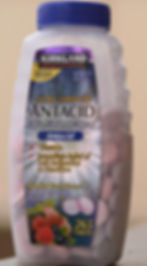Make a Flash Diffuser for Free
- Ed Dozier
- Apr 30, 2019
- 4 min read
Updated: Aug 8, 2020
If this idea hasn’t occurred to you, it’s possible to make a rugged and perfectly functional flash diffuser for free. It won’t even take much time. What have you got to lose?
Flash diffusers are a really good idea to soften your harsh flash output. Even with a diffuser, it’s a good idea to still tilt the flash head for a bounce flash.
You can buy diffusers that are essentially a plastic bottle, but why not just try a plastic bottle instead? I kept my eye out for the right-sized bottle for my (Nikon SB-600) flash, and it wasn’t that hard to find. Your own flash may take a different size, though. It should go without saying that you want a bottle that’s white.
I found the perfect diffuser at Costco: a bottle of antacid tablets. It’s pretty thick plastic, so it won’t readily break or even deform. It has a pretty neutral color, and it doesn’t block too much light. You might find some “Tupper Ware“that you like for the job. Use plastic that isn’t too clear, or it won’t diffuse the light enough.
All you’ll need to make this diffuser is a utility knife, a permanent marker, and maybe some gloves. Please don’t blame me if you cut yourself. Use some good common sense about how you hold the bottle while you perform surgery on it.
After you’ve found a properly-sized bottle and cleaned it up, then use the marker to draw where you need to cut it. If you’re fanatical about this, you might want to even measure the flash dimensions to mark more accurate dimensions. You’ve probably heard the motto “measure twice and cut once”… I actually cut my bottle a little small, and then shaved off a few slivers at a time until I got the fit nice and snug.
When I shot a gray card, the color balance proved to be a little warm with the diffuser, so I had to use a custom white balance to get totally neutral lighting. I guess you have to pay a teeny price for using this cheap diffuser.

Bottle diffuser slips over the flash head
This is a really simple piece of gear. You don’t need any straps or glue or anything to keep the bottle snug for a flash like mine, since it has a slight taper along the head. If you have an inconveniently-shaped flash head, you might need some Velcro to keep it snug.

The naked flash

Flash diffuser disguised as an antacid bottle

Bounce flash, no diffuser, pointed at a fairly high ceiling
In the shot above, the ceiling was too high for the bounce flash; it had little effect on the subject. Sometimes you encounter paneled or colored ceilings which can also defeat the use of bounce flash.

Bounce flash with diffuser, pointed at ceiling
The first thing that jumps out at me in the above comparison shots is the bounce flash level of illumination. With no diffuser, and a fairly high ceiling, the flash didn’t have enough effect. If you’re in a fast-paced situation, it’s a pain to have to worry about angling your flash to bounce off of the nearest wall instead of a ceiling. If the ceiling is really high and you aren’t near a wall, then you basically can’t use bounce flash.
With the diffuser, enough light gets to the subject even if the ceiling/walls are too far away. Light gets through the sides of the diffuser, so the subject gets both diffuse direct light and bounced light.

Gray card, direct flash, no diffuser, with auto white balance

Gray card, direct flash, with diffuser, custom white balance
There’s a plus and a minus to using this diffuser with direct flash. The lighting is definitely more even with the diffuser. The downside is that the color balance is a little warm, so a custom white balance is required to achieve the same color temperature with the diffuser.
As you can see above, the correct custom white balance completely neutralized the warm color. I actually wrote the correct Kelvin temperature (with a permanent marker) onto the diffuser in an inconspicuous place; it makes a good reminder to set the white balance when I use the diffuser. I used the histogram of the gray card photo to see how the R,G,B peaks aligned. With a gray card, the peaks should completely overlap. I adjusted the white balance Kelvin temperature and re-shot the gray card until I got the R,G,B peaks to perfectly overlap.
Conclusion
Using a diffuser means that you will have fewer things to worry about when using a flash. It softens the light when using direct flash. It gets more illumination onto your subject if you’re using bounce flash and you get too far from walls or a too-high ceiling. You don’t have to be as careful about the angle of the bounce flash, either. My cheap diffuser slightly altered the color balance, compared to a bare flash, but it’s easy to correct for this.
This kind of diffuser can’t substitute for the quality you get from a large umbrella reflector, but it’s not a fraction as cumbersome to use, either. I’m not trying to endorse being lazy or cutting corners, but there are times when you just can’t transport elaborate lighting gear.
I have to admit that this diffuser looks a little homely, but it’s easy enough to get over that. It makes flash photography a little simpler for me than using a bare flash, and as I said before, the price is right.


















